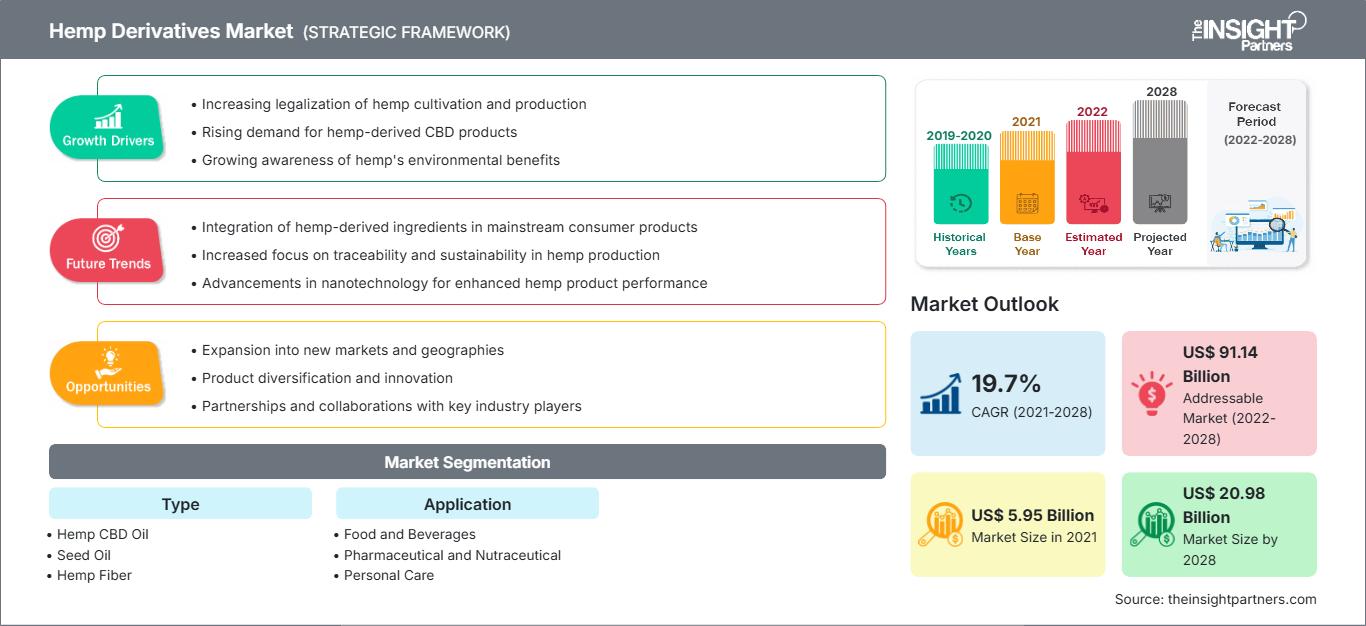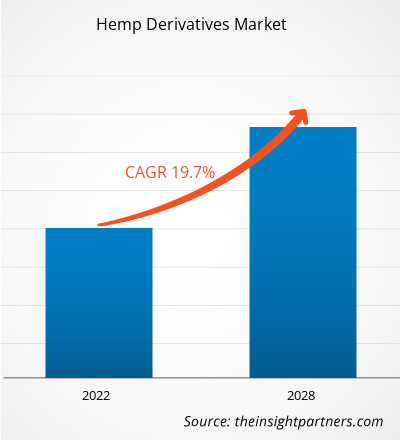El mercado de derivados del cáñamo se valoró en US$ 5.953,86 millones en 2021 y se proyecta que alcance los US$ 20.977,94 millones para 2028; se espera que crezca a una CAGR del 19,7% de 2021 a 2028.
El cáñamo, o cáñamo industrial, es una variedad de la planta Cannabis sativa, cultivada específicamente para uso industrial. Sus derivados, como el CBD, el aceite de semilla y las fibras, se derivan del cáñamo y tienen diversas aplicaciones en diversas industrias, como la alimentaria, la farmacéutica, la de cuidado personal y la de alimentación animal.
En 2021, Asia Pacífico representó la mayor participación en el mercado mundial de derivados del cáñamo. La creciente conciencia sobre los beneficios médicos de los derivados del cáñamo impulsa su uso en la región. Además, estos derivados encuentran diversas aplicaciones en la industria textil. Además, se estima que el auge del mercado de cosméticos y productos de cuidado personal en Asia Pacífico y la legalización del cáñamo industrial en suplementos alimenticios impulsarán el mercado en la región durante el período de pronóstico.
La pandemia de COVID-19 ha tenido un impacto relativamente positivo en el mercado de derivados del cáñamo. Esta pandemia contribuyó a generar conciencia e interés en el sector médico del cáñamo. La crisis ha sido un período desagradable y estresante para la mayoría de la población mundial. Por lo tanto, personas de todo el mundo han comenzado a consumir productos derivados del cáñamo para tratar la ansiedad y el estrés. Varios usuarios importantes han aumentado su consumo. El consumo para trastornos del sueño y la depresión es, a la vez, exagerado. Debido a la mayor atención a la salud y el bienestar durante la pandemia, se ha incrementado la búsqueda en Google sobre los beneficios para la salud que ofrecen los derivados del cáñamo, lo que ha aumentado la concienciación sobre estos derivados. Además, muchos países se han visto afectados por déficits fiscales durante la pandemia. Los gobiernos de los países buscan fuentes de ingresos fiscales. Una posible fuente podría ser la legalización del cáñamo y sus derivados, que podría volverse cada vez más atractiva. Un aumento en la venta de cáñamo y sus derivados por parte de vendedores legales puede generar una posible ganancia fiscal.
Durante la pandemia de COVID-19, se llevaron a cabo diversas investigaciones centradas en el uso del cáñamo y sus derivados para el tratamiento de la COVID-19. Investigadores canadienses realizaron un estudio para determinar si los extractos de Cannabis sativa pueden ayudar a reducir los niveles del receptor de la célula huésped al que se adhiere el virus SARS-CoV-2 para entrar y propagarse. Además, STERO Biotech, una empresa con sede en Israel, ofrece información sobre el uso del cannabis y el CBD como posible tratamiento para la COVID-19. Por lo tanto, diversas investigaciones sobre el cáñamo y sus derivados para determinar su uso en el tratamiento de la COVID-19 están teniendo un impacto positivo en el mercado de derivados del cáñamo.
Personalice este informe según sus necesidades
Obtendrá personalización en cualquier informe, sin cargo, incluidas partes de este informe o análisis a nivel de país, paquete de datos de Excel, así como también grandes ofertas y descuentos para empresas emergentes y universidades.
Mercado de derivados del cáñamo: Perspectivas estratégicas

-
Obtenga las principales tendencias clave del mercado de este informe.Esta muestra GRATUITA incluirá análisis de datos, desde tendencias del mercado hasta estimaciones y pronósticos.
Perspectivas del mercado
Aplicaciones crecientes de los derivados del cáñamo en diversas industrias
El cáñamo se utiliza cada vez más en diversas aplicaciones en diferentes industrias. Las semillas y tortas de cáñamo se utilizan como fuente alternativa de proteínas para alimentos y piensos en la industria de alimentos y bebidas. Además, el aceite obtenido al triturar las semillas de cáñamo se utiliza en la fabricación de jabones, champús, lociones, cosméticos y geles de baño. El aceite de las semillas de cáñamo es rico en aminoácidos, minerales y vitaminas, y se utiliza en suplementos nutricionales, así como en productos medicinales y terapéuticos. Las fibras de cáñamo contienen una alta cantidad de hemicelulosa, junto con una alta capacidad de absorción, lo que lo convierte en un cultivo adecuado para la industria textil. Los tallos y las fibras de cáñamo se utilizan para fabricar ropa, papel, materiales de construcción, plásticos y compuestos, entre otros. La fibra de cáñamo también se utiliza en la fabricación de materiales aislantes y biocompuestos debido a su alta resistencia, biodegradabilidad, propiedades termodinámicas y ligereza. Las fibras de cáñamo se utilizan en la industria de la construcción para la fabricación de materiales como tableros de fibra, estuco y mortero, bloques de cemento, revestimientos, materiales acústicos y envolturas de tuberías. Los compuestos, que se utilizan para fabricar productos derivados del petróleo, también se elaboran a partir de cáñamo. Las semillas de cáñamo son ricas en nutrientes y proteínas y pueden utilizarse como sustituto de la soja. Debido a su contenido proteico, las semillas de cáñamo se utilizan en la producción de importantes productos derivados de la soja, como tofu, mantequilla, queso, hamburguesas, helado y leche. Por lo tanto, el aumento de las aplicaciones de los derivados del cáñamo en diversas industrias ha provocado un aumento de la demanda de derivados del cáñamo, impulsando así su mercado.
Información sobre tipos
Según el tipo, el mercado de derivados del cáñamo se segmenta en aceite de CBD de cáñamo, aceite de semillas, fibra de cáñamo y otros. El segmento de fibra de cáñamo tuvo la mayor participación de mercado en 2021. El cáñamo es una planta de fibra liberiana, como el yute, el kenaf y el lino. Estas fibras se utilizan actualmente como refuerzos en materiales compuestos debido a su biodegradabilidad y menor densidad que las fibras artificiales. La fibra de cáñamo conduce el calor, resiste el moho, se tiñe bien, bloquea la luz ultravioleta y posee propiedades antibacterianas naturales.
Algunos de los principales actores del mercado de derivados del cáñamo son Colorado Hemp Works, Inc.; Dun Agro Hemp Group; Ecofiber; Hempflax Group BV; Hempoland Sp. Z OO; Konoplex, Mh Medical Hemp GmbH; Plains Industrial Hemp Processing Ltd; South Hemp; y BAFA Neu GmbH. Los principales actores del mercado están adoptando estrategias como fusiones y adquisiciones, y lanzamientos de productos para expandir su presencia geográfica y su base de consumidores.
Informe destacado
- Tendencias progresivas en la industria de los derivados del cáñamo para ayudar a los actores a desarrollar estrategias efectivas a largo plazo
- Estrategias de crecimiento empresarial adoptadas por las empresas para asegurar el crecimiento en los mercados desarrollados y en desarrollo
- Análisis cuantitativo del mercado mundial de derivados del cáñamo de 2019 a 2028
- Estimación de la demanda de derivados del cáñamo en diversas industrias
- Análisis de Porter para ilustrar la eficacia de los compradores y proveedores que operan en la industria para predecir el crecimiento del mercado
- Desarrollos recientes para comprender el escenario competitivo del mercado y la demanda de derivados del cáñamo
- Tendencias y perspectivas del mercado junto con los factores que impulsan y restringen el crecimiento del mercado de derivados del cáñamo
- Comprensión de las estrategias que sustentan el interés comercial con respecto al crecimiento del mercado global de derivados del cáñamo, ayudando en el proceso de toma de decisiones.
- Tamaño del mercado de derivados del cáñamo en varios nodos del mercado
- Descripción general detallada y segmentación del mercado mundial de derivados del cáñamo, así como su dinámica industrial.
- Tamaño del mercado de derivados del cáñamo en varias regiones con prometedoras oportunidades de crecimiento
Perspectivas regionales del mercado de derivados del cáñamo
Los analistas de The Insight Partners han explicado detalladamente las tendencias regionales y los factores que influyen en el mercado de derivados del cáñamo durante el período de pronóstico. Esta sección también analiza los segmentos y la geografía del mercado de derivados del cáñamo en América del Norte, Europa, Asia Pacífico, Oriente Medio y África, y América del Sur y Central.
Alcance del informe sobre el mercado de derivados del cáñamo
| Atributo del informe | Detalles |
|---|---|
| Tamaño del mercado en 2021 | 5.950 millones de dólares estadounidenses |
| Tamaño del mercado en 2028 | US$ 20.98 mil millones |
| CAGR global (2021-2028) | 19,7% |
| Datos históricos | 2019-2020 |
| Período de pronóstico | 2022-2028 |
| Segmentos cubiertos |
Por tipo
|
| Regiones y países cubiertos |
América del norte
|
| Líderes del mercado y perfiles de empresas clave |
|
Densidad de actores del mercado de derivados del cáñamo: comprensión de su impacto en la dinámica empresarial
El mercado de derivados del cáñamo está creciendo rápidamente, impulsado por la creciente demanda del consumidor final debido a factores como la evolución de las preferencias de los consumidores, los avances tecnológicos y un mayor conocimiento de los beneficios del producto. A medida que aumenta la demanda, las empresas amplían su oferta, innovan para satisfacer las necesidades de los consumidores y aprovechan las tendencias emergentes, lo que impulsa aún más el crecimiento del mercado.

- Obtenga una descripción general de los principales actores clave del mercado de derivados del cáñamo
Mercado de derivados del cáñamo, por tipo
- Aceite de CBD de cáñamo
- Aceite de semilla
- Fibra de cáñamo
- Otros
Mercado de derivados del cáñamo, por aplicación
- Alimentos y bebidas
- Farmacéutica y nutracéutica
- Cuidado personal
- Textiles
- Otros
Perfiles de empresas
- Colorado Hemp Works, Inc
- Grupo de cáñamo Dun Agro
- Ecofibra
- Grupo Hempflax BV
- Hempoland Sp. Z OO
- Konoplex
- Mh Medical Hemp GmbH
- Procesamiento de cáñamo industrial de las llanuras Ltd.
- Cáñamo del sur
- BAFA Neu GmbH
- Análisis histórico (2 años), año base, pronóstico (7 años) con CAGR
- Análisis PEST y FODA
- Tamaño del mercado, valor/volumen: global, regional y nacional
- Industria y panorama competitivo
- Conjunto de datos de Excel
Informes recientes
Testimonios
Razón para comprar
- Toma de decisiones informada
- Comprensión de la dinámica del mercado
- Análisis competitivo
- Información sobre clientes
- Pronósticos del mercado
- Mitigación de riesgos
- Planificación estratégica
- Justificación de la inversión
- Identificación de mercados emergentes
- Mejora de las estrategias de marketing
- Impulso de la eficiencia operativa
- Alineación con las tendencias regulatorias






















 Obtenga una muestra gratuita para - Mercado de derivados del cáñamo
Obtenga una muestra gratuita para - Mercado de derivados del cáñamo